Italy approves plans for world's largest suspension bridge
With a record 3.3-kilometre span between 400-metre towers, the ambition may be just as high and, possibly, too high.

Italy’s government on Wednesday approved a 13.5-billion-euro project to build the world’s longest suspension bridge, connecting the island of Sicily to the mainland, an official said.
A spokesman for Deputy Prime Minister Matteo Salvini, who is responsible for transport and infrastructure, said a ministerial committee had given the green light to the state-funded bridge over the Strait of Messina, after years of planning.
The bridge has been designed with two railway lines in the middle and three lanes of traffic on either side, with a suspended span of 3.3 kilometres – a world record – stretching between two 400-metre high towers.
Due for completion by 2032, the government says the bridge is at the cutting edge of engineering, able to withstand high winds and earthquakes in a region that lies across two tectonic plates.
Ministers hope it will bring economic growth and jobs to two impoverished Italian regions – Sicily and Calabria on the mainland – with Salvini promising the project will create tens of thousands of jobs.
Yet it has sparked local protests over the environmental impact and the cost that critics say could be better spent elsewhere.
Some critics believe it will never materialise, pointing to a long history of public works announced, financed and never completed in Italy.
From pipe dream to NATO pitch: Meloni tries to rescue long-awaited bridge to Sicily
ROME – Italian Prime Minister Giorgia Meloni is rebranding the long-promised €13 billion Strait of…
4 minutes

The bridge has had several false starts, with the first plans drawn up more than 50 years ago.
Eurolink, a consortium led by Italian group Webuild, won the tender in 2006 only to see it cancelled after the eurozone debt crisis. The consortium remains the contractor on the revived project.
This time, Rome has an added incentive to press ahead — by classifying the cost of the bridge as defence spending.
Debt-laden Italy has agreed, along with other NATO allies, to massively increase its defence expenditure to 5% of GDP, at the demand of US President Donald Trump.
Of this, 1.5% can be spent on “defence-related” areas such as cybersecurity and infrastructure. Rome is hoping the Messina bridge will qualify, particularly as Sicily hosts a NATO base.
UPDATE: The latest decision was added to the article.
(mm)



